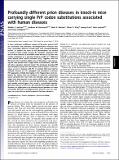Profoundly different prion diseases in knock-in mice carrying single PrP codon substitutions associated with human diseases
Author(s)
Jackson, Walker S.; Borkowski, Andrew W.; Watson, Nicki E.; King, Oliver D.; Faas, Henryk; Jasanoff, Alan Pradip; Lindquist, Susan; ... Show more Show less
DownloadJackson-2013-Profoundly different prion diseases.pdf (906.0Kb)
PUBLISHER_POLICY
Publisher Policy
Article is made available in accordance with the publisher's policy and may be subject to US copyright law. Please refer to the publisher's site for terms of use.
Terms of use
Metadata
Show full item recordAbstract
In man, mutations in different regions of the prion protein (PrP) are associated with infectious neurodegenerative diseases that have remarkably different clinical signs and neuropathological lesions. To explore the roots of this phenomenon, we created a knock-in mouse model carrying the mutation associated with one of these diseases [Creutzfeldt–Jakob disease (CJD)] that was exactly analogous to a previous knock-in model of a different prion disease [fatal familial insomnia (FFI)]. Together with the WT parent, this created an allelic series of three lines, each expressing the same protein with a single amino acid difference, and with all native regulatory elements intact. The previously described FFI mice develop neuronal loss and intense reactive gliosis in the thalamus, as seen in humans with FFI. In contrast, CJD mice had the hallmark features of CJD, spongiosis and proteinase K-resistant PrP aggregates, initially developing in the hippocampus and cerebellum but absent from the thalamus. A molecular transmission barrier protected the mice from any infectious prion agents that might have been present in our mouse facility and allowed us to conclude that the diseases occurred spontaneously. Importantly, both models created agents that caused a transmissible neurodegenerative disease in WT mice. We conclude that single codon differences in a single gene in an otherwise normal genome can cause remarkably different neurodegenerative diseases and are sufficient to create distinct protein-based infectious elements.
Date issued
2013-09Department
Massachusetts Institute of Technology. Department of Biological Engineering; Massachusetts Institute of Technology. Department of Biology; Massachusetts Institute of Technology. Department of Brain and Cognitive Sciences; Massachusetts Institute of Technology. Department of Nuclear Science and Engineering; Whitehead Institute for Biomedical Research; Francis Bitter Magnet Laboratory (Massachusetts Institute of Technology)Journal
Proceedings of the National Academy of Sciences
Publisher
National Academy of Sciences (U.S.)
Citation
Jackson, W. S., A. W. Borkowski, N. E. Watson, O. D. King, H. Faas, A. Jasanoff, and S. Lindquist. “Profoundly Different Prion Diseases in Knock-in Mice Carrying Single PrP Codon Substitutions Associated with Human Diseases.” Proceedings of the National Academy of Sciences 110, no. 36 (August 19, 2013): 14759–14764.
Version: Final published version
ISSN
0027-8424
1091-6490